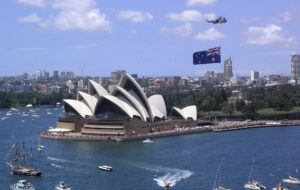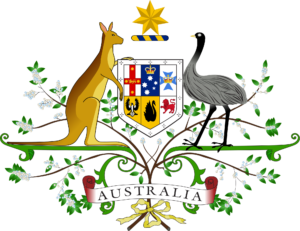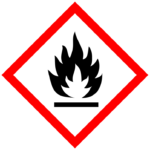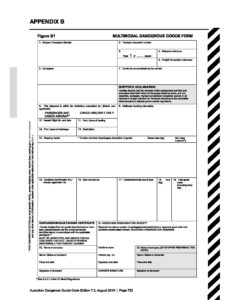Transport in Australia
Written on: April 1, 2015 by SprayTM

In the January issue of Spray, I had described some of the standards for exporting and transporting aerosols and other dangerous goods into Mexico. In this issue, I will share with you some of the country-specific nuances and regulatory requirements for exporting and transporting aerosols and certain other dangerous goods into and within Australia.
 The latest revision to the Australian Dangerous Goods (ADG) Code, Revision 7.3, was published in August 2014 and applies to all jurisdictions within Australia. The ADG was updated to conform to the latest technical requirements for the land transport of dangerous goods across Australia and takes into account the 11th Revised Edition of the United Nations Recommendations on the Transport of Dangerous Goods Model Regulations. There are a number of Australia-specific requirements that have been retained in the latest ADG update, so a detailed review of these requirements should be conducted before exporting aerosols and certain other dangerous goods “down under.”
The latest revision to the Australian Dangerous Goods (ADG) Code, Revision 7.3, was published in August 2014 and applies to all jurisdictions within Australia. The ADG was updated to conform to the latest technical requirements for the land transport of dangerous goods across Australia and takes into account the 11th Revised Edition of the United Nations Recommendations on the Transport of Dangerous Goods Model Regulations. There are a number of Australia-specific requirements that have been retained in the latest ADG update, so a detailed review of these requirements should be conducted before exporting aerosols and certain other dangerous goods “down under.”
Standards
ADG7.3 adopts the structure, format, definitions and concepts of the Recommendations on the Transport of Dangerous Goods Model Regulations, 17th Revised Edition (2011) while retaining some Australian-specific provisions.
The ADG Code provides detailed technical specifications, requirements and recommendations applicable to the transport of dangerous goods in Australia by road and rail, which are consistent with the United Nations’ Model Regulations (UN Orange Book). Dangerous goods consignments shipped to Australia by vessel or air must conform to the International Maritime Dangerous Goods (IMDG) Code or International Civil Aviation Organization (ICO) Technical Instructions for the Transport of Dangerous Goods by Air (respectively), in addition to any carrier-specific restrictions that may apply.
 The Australian definition of aerosols or aerosol dispensers as “… non-refillable receptacles meeting the requirements of [ADG] Section 6.2.4, made of metal, glass or plastics and containing a gas, compressed, liquefied or dissolved under pressure, with or without a liquid, paste or powder, and fitted with a release device allowing the contents to be ejected as solid or liquid particles in suspension in a gas, as a foam, paste or powder or in a liquid state or in a gaseous state” is consistent with the UN’s Model Regulations but is not consistent with the U.S. definition of aerosols, which is “…any non-refillable receptacle containing a gas compressed, liquefied or dissolved under pressure, the sole purpose of which is to expel a nonpoisonous (other than a Division 6.1 Packing Group III material) liquid, paste, or powder and fitted with a self-closing release device allowing the contents to be ejected by the gas.”
The Australian definition of aerosols or aerosol dispensers as “… non-refillable receptacles meeting the requirements of [ADG] Section 6.2.4, made of metal, glass or plastics and containing a gas, compressed, liquefied or dissolved under pressure, with or without a liquid, paste or powder, and fitted with a release device allowing the contents to be ejected as solid or liquid particles in suspension in a gas, as a foam, paste or powder or in a liquid state or in a gaseous state” is consistent with the UN’s Model Regulations but is not consistent with the U.S. definition of aerosols, which is “…any non-refillable receptacle containing a gas compressed, liquefied or dissolved under pressure, the sole purpose of which is to expel a nonpoisonous (other than a Division 6.1 Packing Group III material) liquid, paste, or powder and fitted with a self-closing release device allowing the contents to be ejected by the gas.”
Accordingly, certain dangerous goods that may qualify as “aerosols” within Australia must be appropriately described by their fully regulated basic description when exported from the U.S. Notable examples include replacement refrigerants and dusters.
With respect to the classification of aerosols, ADG Code Special Provision 63 requires that:
-
Division 2.1 applies if the contents include 85% by mass or more flammable components and the chemical heat of combustion is 30 kJ/g or more;
-
Division 2.2 applies if the contents contain 1% by mass or less flammable components and the heat of combustion is less than 20 kJ/g;
-
Otherwise, the product must be classified as tested by the tests described in the Manual of Tests & Criteria, Part III, Section 31. Extremely flammable and flammable aerosols must be classified in Division 2.1; non-flammable in Division 2.2;
-
Gases of Division 2.3 must not be used as a propellant in an aerosol dispenser;
-
Where the contents other than the propellant of aerosol dispensers to be ejected are classified as Division 6.1 packing groups II or III or Class 8 packing groups II or III, the aerosol will have a subsidiary risk of Division 6.1 or Class 8;
-
Aerosols with contents meeting the criteria for packing group I for toxicity or corrosivity are prohibited from transport; and
-
Subsidiary risk labels may be required for air transport.
With respect to limited quantities, ADG Special Provision 277 requires that aerosols containing toxic materials are limited to 120mL per inner receptacle, while all other aerosols are limited to 1000mL per inner receptacle. The total gross mass of each completed package may not exceed 30 kg (66 lbs). Additional exceptions apply to small aerosol receptacles having a volumetric capacity less than or equal to 50mL (1.69 fl oz).
Marking & Labeling Requirements
With respect to packaging, marking, labeling and documentation, the requirements of the ADG Code 7.3 are essentially identical to those of the Hazardous Material Regulations (HMR), IMDG Code and ICAO Technical Instructions. Packaging must conform to the UN Performance Oriented Specification Packaging standards for other than limited quantities. Packages must also be properly marked and labeled with the proper shipping name, UN identification number and corresponding primary and subsidiary risk labels, if applicable. Aerosols in limited quantities offered for surface transport (road/rail) or by vessel need only be marked with the Limited Quantity (hollow diamond) marking as outlined in ADG Code 7.3, section 3.4.7. A smaller limited quantity marking (50 mm x 50 mm) is authorized for smaller outer packaging whose dimensions will not accommodate the diamond-shaped marking.
Additional Aerosol Marking Requirements
All aerosols should be marked in accordance with Australian Standard AS 2278.1. The current version, AS 2278.1-2008 requires that:
-
Aerosol dispensers shall include the applicable warnings and markings, directions for use, and any additional operating precautions that alert consumers to the specific dangers of the product.
-
Flammable and extremely flammable aerosols are marked with one of the three possible pictograms shown in Section 4.3, Figures 1(a), 1(b) or 1(c), each shown below:

- The symbol shall be printed in black on an orange-yellow background and should be no smaller than 10mm x 10mm.

- The symbol shall be printed in black or white on a red background with dimensions as specified by the ADG code.

- The symbol shall be printed in black on a white background with a red frame sufficiently wide as to be clearly visible.
-
All aerosol dispensers shall carry the following consumer safety advice*:
-
PRESSURISED DISPENSER. (note Australian spelling of “pressurized”)
-
PROTECT FROM SUNLIGHT AND DO NOT EXPOSE TO TEMPERATURES EXCEEDING 50°C.
-
DO NOT PIERCE OR BURN, EVEN AFTER USE.
-
All aerosol dispensers classified as “flammable” or “extremely flammable” according to the criteria laid down in the most recent edition of the Manual of Tests and Criteria of the UN Recommendations on the Transport of Dangerous Goods—Model Regulations, shall carry the following additional warnings* in words not less than 2mm in height:
-
EXTREMELY FLAMMABLE
-
DO NOT SPRAY ON A NAKED FLAME OR ANY INCANDESCENT MATERIAL
-
KEEP AWAY FROM SOURCES OF IGNITION—NO SMOKING
-
KEEP OUT OF THE REACH OF CHILDREN
-
Of particular note, all aerosol dispensers must be marked with a batch identifier that enables them to be traced (through markings or documentation) to the manufacturer of the empty aerosol dispenser.
Dangerous Goods Declarations
The Dangerous Goods Declaration specified in ADG 7.3, section 11.1.1, may be in any form, provided it contains all of the information required by the ADG Code. The recommended format (Figure B1) from Appendix B is identical to the Multimodal Dangerous Goods form specified in the UN Recommendations on the Transport of Dangerous Goods and the International Maritime Dangerous Goods (IMDG) Code.
An International Air Transport Association (IATA) Dangerous Goods Declaration may also be used for surface (road/rail) transport within Australia provided it conforms to the applicable requirements of that resource. The information on the dangerous goods transport document must be in English, easy to identify, legible and durable.The contents of transport documentation may be transmitted to the prime contractor or driver by electronic data interchange, but documentation must be carried in the vehicle in hard copy (e.g., paper) form.
Figure B2 is a sample generic transport document that may be used, when correctly completed, in lieu of a transport document that complies with Part 11, for the transport of a Retail Distribution Load that fully complies with all of the conditions prescribed in Chapter 7.3.

- Figure B1
Safety Data Sheets
Safety Data Sheets must also be made available and conform to the Australia Work Health & Safety (WHS) Act and National Code of Practice for the Preparation of Material Safety Data Sheets 2nd Edition [NOHSC:2011(2003)], which require 16 sections. Manufacturers and importers of chemicals are able to continue to use the existing Safety Data Sheet arrangements for workplace hazardous substances and dangerous goods up until Dec. 31, 2016. This applies for chemicals which have been classified according to the Approved Criteria for Classifying Hazardous Substances and the ADG Code. However, in recognition of the pending implementation of the Globally Harmonized System of Classification & Labeling of Chemicals (GHS) requirements in the U.S. and Australia, it is strongly recommended that Safety Data Sheets be made available in the GHS format.

- Figure B2
Additional Resources
Copies of the Australian Dangerous Goods Code, ADG 7.3 can be found here.
Safe Work Australia’s website includes downloadable copies of the National Code of Practice for the Preparation of Material Safety Data Sheets 2nd Edition [NOHSC:2011(2003)]
For questions regarding the transport of dangerous goods to and within Australia, its implementation or impact, or to obtain a copy of any of the Australian Dangerous Goods Code (ADG 7.3), contact steve@shipmate.com or (310) 370-3600.

 The latest revision to the Australian Dangerous Goods (ADG) Code, Revision 7.3, was published in August 2014 and applies to all jurisdictions within Australia. The ADG was updated to conform to the latest technical requirements for the land transport of dangerous goods across Australia and takes into account the 11th Revised Edition of the United Nations Recommendations on the Transport of Dangerous Goods Model Regulations. There are a number of Australia-specific requirements that have been retained in the latest ADG update, so a detailed review of these requirements should be conducted before exporting aerosols and certain other dangerous goods “down under.”
The latest revision to the Australian Dangerous Goods (ADG) Code, Revision 7.3, was published in August 2014 and applies to all jurisdictions within Australia. The ADG was updated to conform to the latest technical requirements for the land transport of dangerous goods across Australia and takes into account the 11th Revised Edition of the United Nations Recommendations on the Transport of Dangerous Goods Model Regulations. There are a number of Australia-specific requirements that have been retained in the latest ADG update, so a detailed review of these requirements should be conducted before exporting aerosols and certain other dangerous goods “down under.” The Australian definition of aerosols or aerosol dispensers as “… non-refillable receptacles meeting the requirements of [ADG] Section 6.2.4, made of metal, glass or plastics and containing a gas, compressed, liquefied or dissolved under pressure, with or without a liquid, paste or powder, and fitted with a release device allowing the contents to be ejected as solid or liquid particles in suspension in a gas, as a foam, paste or powder or in a liquid state or in a gaseous state” is consistent with the UN’s Model Regulations but is not consistent with the U.S. definition of aerosols, which is “…any non-refillable receptacle containing a gas compressed, liquefied or dissolved under pressure, the sole purpose of which is to expel a nonpoisonous (other than a Division 6.1 Packing Group III material) liquid, paste, or powder and fitted with a self-closing release device allowing the contents to be ejected by the gas.”
The Australian definition of aerosols or aerosol dispensers as “… non-refillable receptacles meeting the requirements of [ADG] Section 6.2.4, made of metal, glass or plastics and containing a gas, compressed, liquefied or dissolved under pressure, with or without a liquid, paste or powder, and fitted with a release device allowing the contents to be ejected as solid or liquid particles in suspension in a gas, as a foam, paste or powder or in a liquid state or in a gaseous state” is consistent with the UN’s Model Regulations but is not consistent with the U.S. definition of aerosols, which is “…any non-refillable receptacle containing a gas compressed, liquefied or dissolved under pressure, the sole purpose of which is to expel a nonpoisonous (other than a Division 6.1 Packing Group III material) liquid, paste, or powder and fitted with a self-closing release device allowing the contents to be ejected by the gas.”

